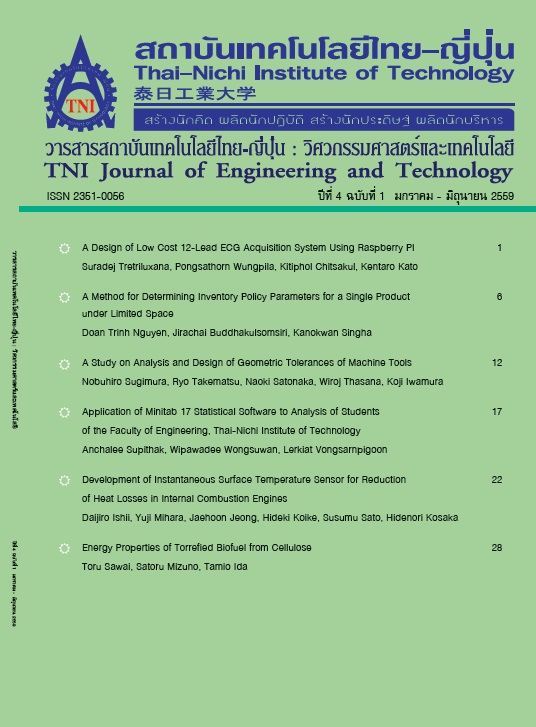Thin Film Sensors for Measuring Oil Film Condition in Machine Sliding Surfaces
Main Article Content
Abstract
In order to reduce CO2 emissions and fuel consumption, the reduction of mechanical friction loss is very important technologies. To reduce such friction loss, understanding the lubrication conditions of engine sliding surfaces are very important. In order to investigate their conditions and to validate the CAE (Computer aided engineering), the author has developed a thin-film pressure, strain, temperature and also thin-film gap sensor and measured the distributions of oil-film condition in sliding surface in machinery main bearings, piston skirts, pinbosses and gear tooth surfaces. In this paper, the structure and form of thin-film sensor especially for piston skirts, plain bearings were discussed and provided a measurement example.
Article Details
Article Accepting Policy
The editorial board of Thai-Nichi Institute of Technology is pleased to receive articles from lecturers and experts in the fields of engineering and technology written in Thai or English. The academic work submitted for publication must not be published in any other publication before and must not be under consideration of other journal submissions. Therefore, those interested in participating in the dissemination of work and knowledge can submit their article to the editorial board for further submission to the screening committee to consider publishing in the journal. The articles that can be published include solely research articles. Interested persons can prepare their articles by reviewing recommendations for article authors.
Copyright infringement is solely the responsibility of the author(s) of the article. Articles that have been published must be screened and reviewed for quality from qualified experts approved by the editorial board.
The text that appears within each article published in this research journal is a personal opinion of each author, nothing related to Thai-Nichi Institute of Technology, and other faculty members in the institution in any way. Responsibilities and accuracy for the content of each article are owned by each author. If there is any mistake, each author will be responsible for his/her own article(s).
The editorial board reserves the right not to bring any content, views or comments of articles in the Journal of Thai-Nichi Institute of Technology to publish before receiving permission from the authorized author(s) in writing. The published work is the copyright of the Journal of Thai-Nichi Institute of Technology.
References
M. Yuji, M. Tomomi, and S. Tsuneo, “Measurement of Piston Pinboss Oil-film Pressure in Engine Operating Condition using a Thinfilm Sensor,” Transactions of Society of Automotive Engineers of Japan, vol. 39, no. 3, 2008.
Y. Mihara, Measurement of oil film pressure in piston Skirt using multi-layered thin-film sensor. Japan: Transactions of the Society of Automotive Engineers of Japan, 2012.
K. Miura, Development of thin-film sensor for oil-film condition. Japan: Society of Mechanical Engineers of Japan, 2015.
M. Kamiya, T. Kobayashi, Y. Mihara, and T. Someya, “Measurement of Piston Skirt Oil-film Pressure under Piston Slap,” SAE 2007 Noise and Vibration Conference and Exhibition, SAE Technical Paper 2007-01-2215, 2007.
M. Tsujioka, Structure Control of DLC Film and Its Applications. Japan: Transactions of Society of


